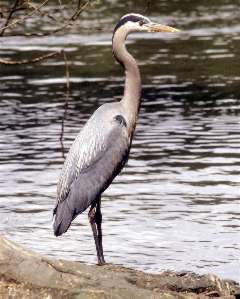Overview
 Order: Pelecaniformes
Order: Pelecaniformes
Family: Ardeidae
Species: Ardea cinerea
Distribution: All over Great Britain from Ireland across to Europe, Asia, Japan & south to the Mediterranean. Also India and northern China, southern Africa, Indonesia. Birds in northern Europe migrate, wintering south of the Sahara.
Habitat: Slow-moving streams and rivers, shallow lakes and sheltered seashores, damp fields, marshes and canals.
Description: Tall with long neck, long brown legs and long, yellow dagger-like beak. Grey upper parts, white head and neck; broad black streak from above the eye through to a long crest.
Size: Length:- up to 98cm. Head and neck longer than the body. Wingspan:- up to 195cm. Weight:- about 1500g.
Life-span: Oldest ringed bird recorded, 25 years, 4 mths.
Food: Fish, small mammals, amphibians, reptiles, insects, small birds, crabs. The heron is Britain's tallest bird and one of the most easily recognised. Its outline is quite distinctive, whether it is standing motionless at the water's edge or flying, silhouetted against the sky.
Read More: Daily Life